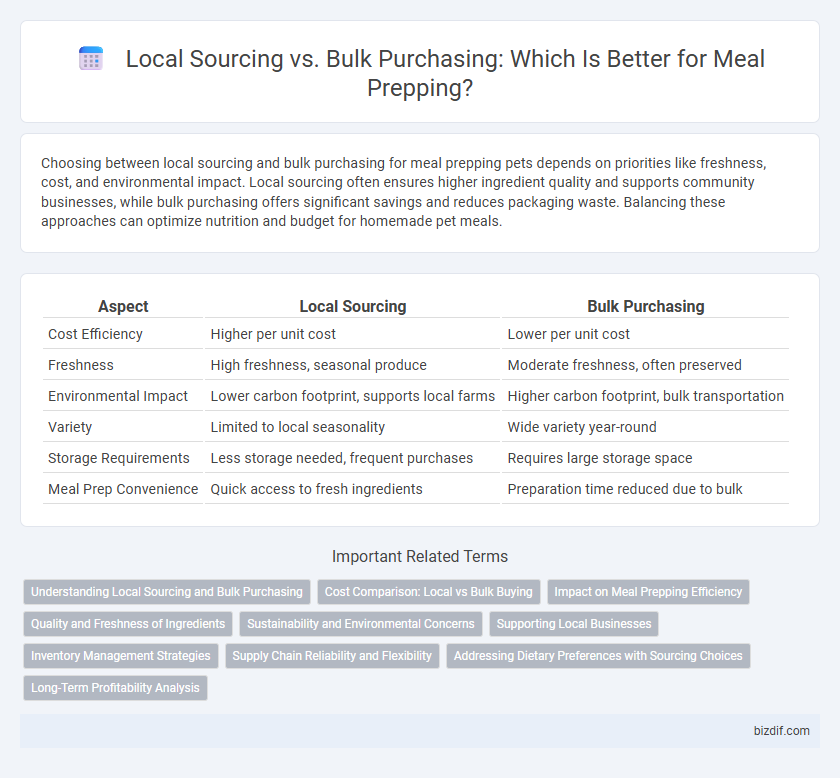Choosing between local sourcing and bulk purchasing for meal prepping pets depends on priorities like freshness, cost, and environmental impact. Local sourcing often ensures higher ingredient quality and supports community businesses, while bulk purchasing offers significant savings and reduces packaging waste. Balancing these approaches can optimize nutrition and budget for homemade pet meals.
Table of Comparison
| Aspect | Local Sourcing | Bulk Purchasing |
|---|---|---|
| Cost Efficiency | Higher per unit cost | Lower per unit cost |
| Freshness | High freshness, seasonal produce | Moderate freshness, often preserved |
| Environmental Impact | Lower carbon footprint, supports local farms | Higher carbon footprint, bulk transportation |
| Variety | Limited to local seasonality | Wide variety year-round |
| Storage Requirements | Less storage needed, frequent purchases | Requires large storage space |
| Meal Prep Convenience | Quick access to fresh ingredients | Preparation time reduced due to bulk |
Understanding Local Sourcing and Bulk Purchasing
Local sourcing involves obtaining fresh, seasonal ingredients directly from nearby farms and producers, ensuring high-quality and environmentally sustainable meal prep components. Bulk purchasing focuses on acquiring large quantities of staple items, such as grains, beans, and frozen vegetables, which can reduce costs and minimize frequent shopping trips. Understanding the balance between local sourcing and bulk purchasing helps optimize meal prep efficiency, cost, and ingredient freshness.
Cost Comparison: Local vs Bulk Buying
Local sourcing often involves higher per-unit costs due to smaller quantities and premium quality, while bulk purchasing provides significant cost savings by leveraging volume discounts and lower unit prices. Bulk buying reduces overall grocery expenses, especially for staple ingredients like grains, legumes, and frozen vegetables commonly used in meal prepping. However, local sourcing supports fresh, seasonal produce that may reduce waste and enhance flavor, potentially offsetting some cost differences through quality and sustainability benefits.
Impact on Meal Prepping Efficiency
Local sourcing enhances meal prepping efficiency by providing fresh ingredients that reduce spoilage and prep time, enabling quicker assembly and higher nutritional value. Bulk purchasing cuts costs and ensures ingredient availability but may increase storage needs and the risk of food waste if portions aren't planned accurately. Balancing local sourcing with strategic bulk buying optimizes both freshness and budget, streamlining meal prep workflows.
Quality and Freshness of Ingredients
Local sourcing ensures the highest quality and freshness of ingredients by minimizing the time between harvest and meal preparation, preserving flavor and nutritional value. Bulk purchasing can reduce costs but often compromises ingredient freshness due to longer storage and transportation times. Prioritizing local suppliers supports seasonal, nutrient-rich produce, which directly enhances the overall taste and health benefits of meal-prepped dishes.
Sustainability and Environmental Concerns
Local sourcing in meal prepping reduces carbon emissions by minimizing transportation distance and supports sustainable agriculture practices, which helps preserve biodiversity and soil health. Bulk purchasing often decreases packaging waste and can lower costs but may increase the carbon footprint due to long-distance shipping and storage energy use. Balancing local sourcing with strategic bulk buying offers the most environmentally responsible approach to sustainable meal prepping.
Supporting Local Businesses
Supporting local businesses through meal prepping encourages community growth by sourcing fresh, seasonal ingredients from nearby farmers and markets. Local sourcing reduces environmental impact by minimizing transportation emissions and often provides higher nutritional value compared to bulk-purchased, processed items. While bulk purchasing offers cost savings, prioritizing local products fosters sustainable economies and enhances the quality of home-cooked meals.
Inventory Management Strategies
Local sourcing supports fresher ingredients and reduces waste by allowing more precise inventory control, ideal for meal prepping with perishable items. Bulk purchasing lowers costs but requires advanced inventory management techniques such as rotation systems, proper storage, and accurate demand forecasting to prevent spoilage. Effective meal prep inventory strategies balance these approaches to optimize freshness, cost-efficiency, and minimize food waste.
Supply Chain Reliability and Flexibility
Local sourcing in meal prepping enhances supply chain reliability by reducing transportation delays and minimizing disruption risks, ensuring fresher ingredients. Bulk purchasing offers flexibility through consistent inventory levels and cost savings but may face challenges like longer lead times and storage limitations. Balancing these approaches can optimize supply chain performance, combining the freshness of local produce with the scalability of bulk inventories.
Addressing Dietary Preferences with Sourcing Choices
Local sourcing enhances meal prepping by providing fresher, seasonal ingredients that better accommodate specific dietary preferences such as organic, gluten-free, or vegan options. Bulk purchasing offers cost-effective access to staples like grains, legumes, and frozen vegetables, supporting consistent meal plans for diverse diets. Balancing local sourcing with bulk buying allows meal preppers to maintain nutritional quality while meeting personalized dietary needs affordably.
Long-Term Profitability Analysis
Local sourcing ensures fresh, high-quality ingredients that support sustainable farming and reduce transportation costs, enhancing brand value over time. Bulk purchasing offers immediate cost savings through volume discounts but risks spoilage and inventory management challenges. Analyzing long-term profitability favors a balanced strategy that combines local sourcing for premium meal quality with selective bulk purchasing to optimize cost-efficiency and minimize waste.
Local Sourcing vs Bulk Purchasing Infographic

 bizdif.com
bizdif.com